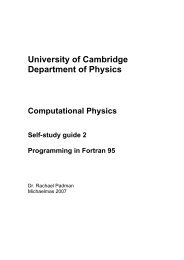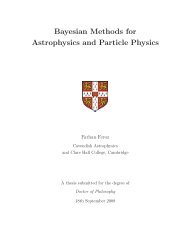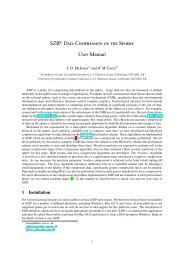Introduction to thermodynamics
Introduction to thermodynamics
Introduction to thermodynamics
Create successful ePaper yourself
Turn your PDF publications into a flip-book with our unique Google optimized e-Paper software.
Statistical and Quantum Physics 8<br />
6.4.2 Other Gases<br />
This calculation works very well for mona<strong>to</strong>mic gases,<br />
but it gives the wrong answer for molecular gases<br />
such as oxygen and nitrogen. At room temperature,<br />
their ratios of heat capacities are about 1.4.<br />
This means that the internal energy density must<br />
be greater than U = NA 3<br />
2kT . In other words, there<br />
must be more ways of s<strong>to</strong>ring energy in the gas than<br />
simply in the translational motion of the molecules.<br />
One solution would be <strong>to</strong> s<strong>to</strong>re the energy in the<br />
rotational energy of the molecules about their three<br />
independent rotational axes. The additional terms<br />
in the internal energy would then be<br />
1<br />
2Ixω 2 x + 1<br />
2Iyω 2 y + 1<br />
2Izω 2 z, (6.26)<br />
where Ix, Iy, Iz are the moments of inertia about<br />
the x, y and z axes and ωx, ωy, ωz their angular<br />
frequencies of rotation about these axes. We could<br />
have performed exactly the same sort of simulation<br />
which we carried out for the translation motion of<br />
the particles and we would have found again that<br />
in statistical equilibrium, each of these terms would<br />
have an energy 1kT<br />
. Therefore, the <strong>to</strong>tal internal<br />
2<br />
energy of the gas would be 3N0kT , CV = 3R, Cp =<br />
4R and so the ratio of heat capacities would be<br />
γ = Cp<br />
CV<br />
= 1.333. (6.27)<br />
This flew in the face of the experimental evidence<br />
which clearly demonstrated that γ = 1.4 for dia<strong>to</strong>mic<br />
gases. This was a major problem for the kinetic<br />
theory of gases and it was only resolved once<br />
the concept of quantisation was introduced by Einstein<br />
in 1905. This is a s<strong>to</strong>ry which we will take up<br />
in the Easter term.<br />
6.5 The Meaning of Temperature<br />
Let us reflect on a problem lurking behind our treatment<br />
of thermal physics so far. We have unambiguous<br />
definitions of pressure and volume, but we lack<br />
a satisfac<strong>to</strong>ry definition of temperature in terms of<br />
fundamental physics.






